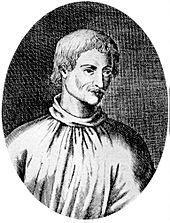Cosmic pluralism
This article needs additional citations for verification. (February 2008) |

Cosmic pluralism, the plurality of worlds, or simply pluralism, describes the belief in numerous "worlds" (planets, dwarf planets or natural satellites) in addition to Earth (possibly an infinite number), which may harbour extraterrestrial life.
The debate over pluralism began as early as the time of Anaximander (c. 610 – c. 546 BC) as a metaphysical argument,[2] long predating the scientific Copernican conception that the Earth is one of numerous planets. It has continued, in a variety of forms, until the modern era.
Ancient Greek debates
In
Medieval Islamic thought
Many medieval Muslim scholars endorsed the idea of cosmic pluralism. Imam Muhammad al-Baqir (676–733) wrote "Maybe you see that God created only this single world and that God did not create humans besides you. Well, I swear by God that God created thousands and thousands of worlds and thousands and thousands of humankind."[7]
Two Qur'anic verses support the idea of God being Lord of multiple worlds: 1:2 and 41:09. Qur'an 16:8 says "He has created other things of which ye have no knowledge."[7] However, some scholars argued that the expression used in the verses simply means "The Lord of all people".[8]
Cosmic pluralism was depicted in fictional
Scholastic thinkers
Eventually, the Ptolemaic-Aristotelian system was challenged and pluralism reasserted, first tentatively by
Renaissance
Giordano Bruno introduced in his works the idea of multiple worlds instantiating the infinite possibilities of a pristine, indivisible One. Bruno (from the mouth of his character Philotheo) in his De l'infinito universo et mondi (1584) claims that "innumerable celestial bodies, stars, globes, suns and earths may be sensibly perceived therein by us and an infinite number of them may be inferred by our own reason."[12]
Teaching this was among the charges the Inquisition made against him.[13]
Enlightenment
During the
The French astronomer Camille Flammarion was one of the chief proponents of cosmic pluralism during the latter half of the nineteenth century. His first book, La pluralité des mondes habités (1862) was a great popular success, going through 33 editions in its first twenty years. Flammarion was one of the first people to put forward the idea that extraterrestrial beings were genuinely alien, and not simply variations of earthly creatures.[15]
Modern thought
In the late nineteenth and twentieth centuries, the term "cosmic pluralism" became largely archaic as knowledge diversified and the speculation on extraterrestrial life focused on particular bodies and observations. The historic debate continues to have modern parallels, however. Carl Sagan and Frank Drake, for instance, could well be considered "pluralists" while proponents of the Rare Earth hypothesis are modern skeptics.
Modern Islamic scholars like Abdullah Yusuf Ali point to the Qur'an (42:29) to argue for life on other planets: "And among His Signs is the creation of the heavens and the earth, and the living creatures that He has scattered through them". The verses uses the word da’bbah, which denotes living creatures on the surface of a planet.[7] Other scholars like Herbert Eisenstein argued however that the word also refer to animals in general.[16]
See also
- Buddhist cosmology
- Extraterrestrial life
- Exoplanet
- Exotheology
- Extraterrestrial life in fiction
- Hindu cosmology
- Mediocrity principle
- Mormon cosmology
- Planetary habitability
- Quiet and loud aliens
References
- ^ Virgilio Salvestrini, Bibliografia di Giordano Bruno, Firenze, 1958
- ^ Simplicius, Commentary on Aristotle's Physics, 1121, 5–9 (English translation in: Simplicius, On Aristotle Physics 8.1-5, Translated by István Bodnár, Michael Chase and Michael Share, New York, Bloomsbury, 2012, p. 22).
- ^ Plutarch. De tranquillitate animi.
- ^
Michael J. Crowe (1999). The Extraterrestrial Life Debate, 1750–1900. ISBN 0-486-40675-X.
- ^ David Darling, "Pluralism (plurality of worlds)"
- ^ Wiker, Benjamin D. (November 4, 2002). "Alien Ideas: Christianity and the Search for Extraterrestrial Life". Crisis Magazine. Archived from the original on February 10, 2003.
- ^ a b c d David A. Weintraub (2014). "Islam," Religions and Extraterrestrial Life (pp 161-168). Springer International Publishing.
- ^ Reynolds, Gabriel Said "The Qur'an and the Bible: Text and commentary" Yale University Press, 2018, p. 30.
- ISBN 1-86064-983-1.
- ^ Dick, Steven J. Plurality of Worlds: The Extraterrestrial Life Debate from Democritus to Kant. Cambridge University Press (June 29, 1984). pgs 35-42.
- ^ "Medieval & Renaissance Astronomy", Australia Telescope National Facility. Commonwealth Scientific and Industrial Research Organisation. Retrieved from http://www.atnf.csiro.au/outreach/education/senior/cosmicengine/renaissanceastro.html on March 14, 2014.
- ISBN 9781317677666. Retrieved 29 March 2015.
- ^ Luigi Firpo, Il processo di Giordano Bruno, 1993.
- ^ Conversations on the Plurality of Worlds— Bernard Le Bovier de Fontenelle
- ^ Flammarion, (Nicolas) Camille (1842–1925)— The Internet Encyclopedia of Science
- ^ Eisenstein, Herbert "Animal life; Encyclopedia of the Qur'an Vol I" Brill, 2001, p. 94.
Further reading
- Ernst Benz (1978). Kosmische Bruderschaft. Die Pluralität der Welten. Zur Ideengeschichte des Ufo-Glaubens. Aurum Verlag. ISBN 3-591-08061-6. (later titled "Außerirdische Welten. Von Kopernikus zu den Ufos")
